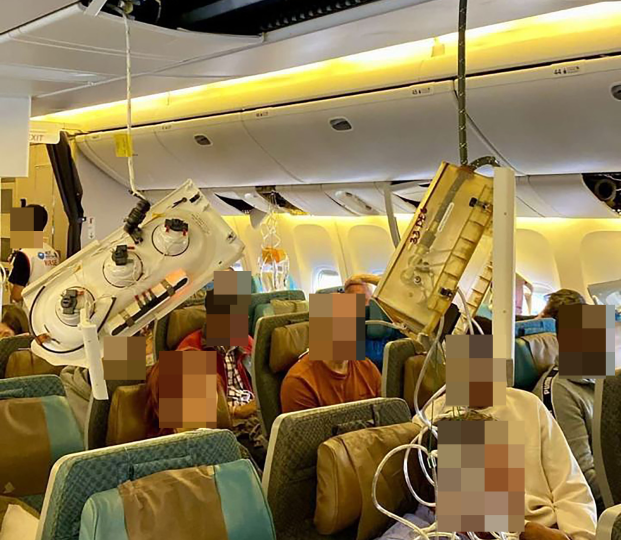SOME 30 people are in hospital and one man, believed to be a Brit, has died following “severe turbulence” on a Singapore Airlines flight.
The tragedy should serve as a reminder to passengers and flight crew about how crucial seatbelts are to in-flight safety, says an expert.
East2WestPassengers and cabin crew were not wearing seatbelts when tragedy struck, says an expert[/caption]
East2WestCrew members appear terrified, one with blood pouring from her nose[/caption]
ViralPressThe ceiling of the Boeing plane is ripped apart during the turbulence[/caption]
East2WestPassengers grip their seats and each other amid turbulence[/caption]
Dents are left in overhead lockers after passengers smashed into them
There were multiple injures and one death onboard flight SQ321 from London to Singapore following “severe turbulence”, Singapore Airlines confirmed on Tuesday afternoon.
The flight had left London Heathrow shortly after 10pm on Monday with 211 passengers and 18 crew members on board.
One man, a 73-year-old Brit travelling in premium economy with his wife, is understood to have died from a possible heart attack as the Boeing 777-300ER plane plunged 7,000 feet in six minutes.
Passengers were eating their breakfast when violent turbulence sent them flying up and out of their seats into the ceiling.
Shocking pictures taken onboard showed people slumped in chairs with smashed noses and bloody faces, with ceilings ripped apart and dents in overhead lockers where bodies had slammed into them.
Unfinished meals were seen strewn across the galley kitchen of the plane, along with kettles, rubbish, and bottles of wine.
Aviation expert and former RAF pilot David Learmount said the aftermath of the horror turbulence suggested few people – including cabin crew members – had been wearing their seatbelts.
He told The Sun: “Now the indication there is that the crew didn’t know this turbulence was coming, or they weren’t expecting it to be anything like it actually turned out to be.
“So everybody on the aircraft was relatively unprepared, and that’s dangerous.
“If you have your seatbelt loosely fastened at all times, this kind of disaster will not happen to you.
“It would be very uncomfortable, but at least you won’t get thrown at the ceiling.”
The severity of the turbulence was “very rare”, he said, and hardly any prior instances had led to the death of a passenger.
Those onboard the flight would not have “come to any harm” – even if the turbulence had been terrible and all of the catering trolleys had been out – if they had been strapped in, the expert claimed.
He went on: “But just looking at some of the early data that’s coming out with regard to this, it sounds absolutely terrifying.
“Six thousand feet – that’s 2,000 metres – in a matter of minutes, the airliner appears to have dropped.
“That is something that would be a really horrifying experience to go through.”
In all of his years as a RAF pilot, he said he had never experienced the type of violent turbulence that might see a plane drop 6,000 feet – or 7,000 feet, according to flight tracker FlightRadar24 figures.
The packed Boeing jet was smashed with turbulence yesterday as passengers ate their breakfast, officials said.
The flight was diverted to the Suvarnabhumi International Airport in Bangkok where it made an emergency landing shortly before 4pm local time.
One person onboard told Reuters that passengers were not wearing their seatbelts when the turbulence suddenly jolted the plane.
Singapore Airlines said on Tuesday afternoon: “We can confirm that there are multiple injuries and one fatality on board the Boeing 777-300ER aircraft.
“As of 1950hrs Singapore time on 21 May 2024, 18 individuals have been hospitalised. Another 12 are being treated in hospitals.”
The flag carrier added: “Singapore Airlines offers its deepest condolences to the family of the deceased.
“Our priority is to provide all possible assistance to all passengers and crew on board the aircraft.
“We are working with the local authorities in Thailand to provide the necessary medical assistance, and sending a team to Bangkok to provide any additional assistance needed.”
Boeing also released a statement on Tuesday, stating: “We extend our deepest condolences to the family who lost a loved one and our thoughts are with the passengers and crew.”
Turbulence deaths are rare tragedies
By Lisa Minot, Head of Travel
THE idea that a flier can be killed by turbulence will strike fear into the hearts of many who have experienced it on a flight.
Nervous fliers often cite the terrifying experience of turbulence as the reason they are so scared of taking to the skies. Even the most confident flyer can feel panic when a plane begins to rattle and roll.
But in reality, this is a relatively rare occurrence. There have been just 38 deaths in the last 15 years, with another 30 passengers and 116 crew seriously injured. Compare that to the more than 4.4billion people who take to the skies each year around the world.
Jet streams, atmospheric pressure and storms are the most common reasons for turbulence but the most dangerous is clear air turbulence as pilots have no warning and time to put seabelt signs on.
However, just three percent of flights experience light turbulence, one per cent of them get moderate episodes and mere tenths of one percent experience severe issues.
When moderate or severe turbulence does lead to injuries, it is passengers not wearing their seatbelt or standing in aisles or toilets who are most at risk.
Keeping your seatbelt on for the entire flight is the most sensible way to ensure that should the worst happen, you are taking the best precautions possible.
ViralPressPassengers’ unfinished meals are seen strewn across the galley kitchen of the plane[/caption]
East2WestPassengers are helped off the plane into wheelchairs[/caption]
Masks drop from the ceiling of the Boeing plane
x/@nnthotnewsEmergency services prepare for the arrival of the plane in Bangkok[/caption]
Leave a comment








